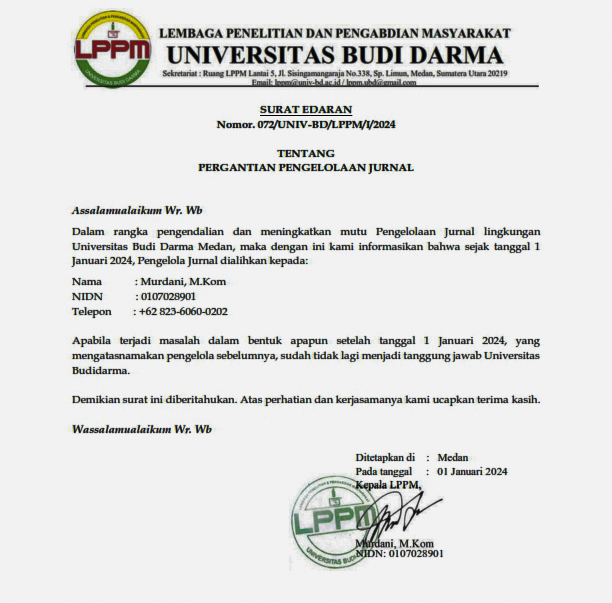Implementation of Global Vectors for Word Representation (GloVe) Model and Social Network Analysis through Wonderland Indonesia Content Reviews
DOI:
https://doi.org/10.30865/json.v5i3.7569Keywords:
Wonderland Indonesia, Alffy Rev, Creative Content, Social Network Analysis, Topic AnalysisAbstract
Integrating the Global Vectors for Word Representation (GloVe) Model with Social Network Analysis presents a promising approach for extracting nuanced semantic relationships from Wonderland Indonesia's content reviews. However, the lack of comprehensive studies exploring the effectiveness of this integration, specifically within the context of Wonderland Indonesia's content reviews, necessitates focused research to uncover its potential impact and applications. This study investigates the reception and impact of the "Wonderland Indonesia" video content by Alffy Rev ft. Novia Bachmid (Chapter 1) within the YouTube community using a comprehensive methodology based on CRoss-Industry Standard Process for Data Mining (CRISP-DM), topic analysis, and Social Network Analysis (SNA). Through topic analysis, the content's main themes and narrative elements were identified, shedding light on its storytelling effectiveness. Furthermore, sentiment analysis using Vader was conducted on 2204 out of 24185 posts, revealing that 1369 (92%) exhibited positive sentiment, 427 (31.19%) had neutral sentiment, and 850 (62.09%) contained negative sentiment. Additionally, sentiment analysis using TextBlob was performed on the same subset of posts, with 1369 (40) posts exhibiting positive sentiment, 599 (43.75%) with neutral sentiment, and 730 (53.32%) expressing negative sentiment. Notably, metrics such as toxicity (highest value: 0.90780) and severe toxicity (highest value: 0.95021) exhibited varying prominence within the analyzed content. These findings enable targeted interventions and content moderation strategies to promote healthier online discourse. The SNA uncovered intricate social dynamics and interaction patterns among viewers, emphasizing the video's ability to foster engagement and community interaction. This study underscores the significance of creative storytelling and community engagement strategies in digital content creation, with implications for audience participation and community development within the digital sphere. Future research could explore the longitudinal effects of such content strategies on audience retention and community engagement.References
M. GarcÃa-Sampedro, S. Agudo Prado, and A. Torralba-Burrial, “Pre-service teachers’ skills development through educational video generation,†Eur. J. Teach. Educ., vol. 00, no. 00, pp. 1–19, 2024, doi: 10.1080/02619768.2024.2323925.
Y. S. Yang, M. J. Seo, and J. Byun, “The Experience of Video Interpretation and Satisfaction,†Tour. Plan. Dev., pp. 1–15, 2024, doi: 10.1080/21568316.2024.2306350.
T. Ozturk, E. Sheydayev, and A. Yagci, “Do YouTube Videos Provide Enough Reliable Information to Patients about White Spot Lesions? A Video Content and Quality Analysis,†J. Consum. Health Internet, vol. 26, no. 4, pp. 357–372, 2022, doi: 10.1080/15398285.2022.2115704.
A. Aigelova, A. Ishanova, and A. Suleimenova, “Analysis of the Content of the Kazakhstan Segment of YouTube,†Q. Rev. Film Video, vol. 0, no. 0, pp. 1–17, 2023, doi: 10.1080/10509208.2023.2265784.
J. L. Besada, “Cover, Custom, and DIY? Memetic Features in Multimedia Creative Practices,†Contemp. Music Rev., vol. 41, no. 4, pp. 382–400, 2022, doi: 10.1080/07494467.2022.2087389.
L. Edwards and B. Owen-Booth, “An exploration of engagement in community based creative activities as an occupation for older adults,†Irish J. Occup. Ther., vol. 49, no. 1, pp. 51–57, Jan. 2021, doi: 10.1108/IJOT-05-2020-0009.
N. Nicoli, K. Henriksen, M. Komodromos, and D. Tsagalas, “Investigating digital storytelling for the creation of positively engaging digital content,†EuroMed J. Bus., vol. 17, no. 2, pp. 157–173, Jan. 2022, doi: 10.1108/EMJB-03-2021-0036.
A.-Z. He, Y. Cai, L. Cai, and Y. Zhang, “Conversation, storytelling, or consumer interaction and participation? The impact of brand-owned social media content marketing on consumers’ brand perceptions and attitudes,†J. Res. Interact. Mark., vol. 15, no. 3, pp. 419–440, Jan. 2021, doi: 10.1108/JRIM-08-2019-0128.
V. RodrÃguez Ortega, “Audiovisual streaming, networked memory & Netflix: the spectator-interface,†Creat. Ind. J., vol. 0, no. 0, pp. 1–16, 2022, doi: 10.1080/17510694.2022.2150814.
B. Zheng, J. Yu, B. Zhang, and C. Shen, “Reconceptualizing translation and translators in the digital age: YouTube comment translation on China’s Bilibili,†Transl. Stud., vol. 16, no. 2, pp. 297–316, 2023, doi: 10.1080/14781700.2023.2205423.
D. Giomelakis, O. Papadopoulou, S. Papadopoulos, and A. Veglis, “Verification of News Video Content: Findings from a Study of Journalism Students,†Journal. Pract., vol. 17, no. 5, pp. 1068–1097, 2023, doi: 10.1080/17512786.2021.1965905.
T. Evens, A. Henderickx, and L. De Marez, “Generation Stream: The Audiovisual Repertoire of Teenagers,†J. Broadcast. Electron. Media, vol. 65, no. 2, pp. 185–204, 2021, doi: 10.1080/08838151.2021.1944146.
J. Salder, “The creative business: enterprise development in the arts-based creative industries,†Creat. Ind. J., vol. 14, no. 1, pp. 1–18, 2020, doi: 10.1080/17510694.2020.1789414.
S. Bisping, “From aims to results: justifying and implementing Japanese cultural policies in Southeast Asia,†Int. J. Cult. Policy, vol. 28, no. 4, pp. 461–475, 2022, doi: 10.1080/10286632.2021.1967942.
A. M. Möller and M. Boukes, “Satirizing the Clothing Industry on YouTube: How Political Satire and User Comments Jointly Shape Behavioral Intentions,†Media Psychol., vol. 25, no. 5, pp. 724–739, 2022, doi: 10.1080/15213269.2022.2066004.
Y. A. Singgalen, “Selling vegetables through live streaming : sentiment and network analysis,†Int. J. Soc. Sci. Econ. Art, vol. 13, no. 4, pp. 240–254, 2024.
Y. A. Singgalen, “Social network and sentiment analysis of product reviews ( case of smartwatch product content ),†Int. J. Soc. Sci. Econ. Art, vol. 13, no. 4, pp. 255–267, 2024.
Y. A. Singgalen, “Toxicity and Social Network Analysis of Green Marketing Content for Electric Cars through Digital Media,†Int. J. Soc. Sci. Econ. Art, vol. 13, no. 4, pp. 268–280, 2024.
J. Sixto-GarcÃa, A. I. RodrÃguez-Vázquez, and X. López-GarcÃa, “News Sharing Using Self-destructive Content in Digital Native Media from an International Perspective,†Journal. Pract., vol. 17, no. 7, pp. 1341–1356, 2023, doi: 10.1080/17512786.2021.2000883.
A. Bruzos, “‘Language hackers’: YouTube polyglots as representative figures of language learning in late capitalism,†Int. J. Biling. Educ. Biling., vol. 26, no. 10, pp. 1210–1227, 2023, doi: 10.1080/13670050.2021.1955498.
A. Inversini, N. L. Williams, I. Rega, and I. Samakovlis, “Modelling Twitter conversations in #favela towards the conceptualization of the eVoice of the unheard,†J. Information, Commun. Ethics Soc., vol. 18, no. 4, pp. 529–551, Jan. 2020, doi: 10.1108/JICES-09-2019-0101.
P. Capriotti, I. Zeler, and A. Oliveira, “Assessing dialogic features of corporate pages on Facebook in Latin American companies,†Corp. Commun. An Int. J., vol. 26, no. 5, pp. 16–30, Jan. 2021, doi: 10.1108/CCIJ-10-2020-0149.
P. MadzÃk, L. Falát, L. CopuÅ¡, and M. Valeri, “Digital transformation in tourism: bibliometric literature review based on machine learning approach,†Eur. J. Innov. Manag., vol. 26, no. 7, pp. 177–205, Jan. 2023, doi: 10.1108/EJIM-09-2022-0531.
M. Talafidaryani, “A text mining-based review of the literature on dynamic capabilities perspective in information systems research,†Manag. Res. Rev., vol. 44, no. 2, pp. 236–267, Jan. 2021, doi: 10.1108/MRR-03-2020-0139.
A. Lopez and R. Garza, “Do sensory reviews make more sense? The mediation of objective perception in online review helpfulness,†J. Res. Interact. Mark., vol. 16, no. 3, pp. 438–456, Jan. 2022, doi: 10.1108/JRIM-04-2021-0121.
S. K. Trivedi, P. Patra, A. Singh, P. Deka, and P. R. Srivastava, “Analyzing the research trends of COVID-19 using topic modeling approach,†J. Model. Manag., vol. 18, no. 4, pp. 1204–1227, Jan. 2023, doi: 10.1108/JM2-02-2022-0045.
P. Pramanik and R. K. Jana, “Identifying research trends of machine learning in business: a topic modeling approach,†Meas. Bus. Excell., vol. 27, no. 4, pp. 602–633, Jan. 2023, doi: 10.1108/MBE-07-2021-0094.
E. (Olivia) Park, B. (Kevin) Chae, and J. Kwon, “The structural topic model for online review analysis,†J. Hosp. Tour. Technol., vol. 11, no. 1, pp. 1–17, Jan. 2020, doi: 10.1108/JHTT-08-2017-0075.
N. Cobelli and S. Blasi, “Combining topic modeling and bibliometric analysis to understand the evolution of technological innovation adoption in the healthcare industry,†Eur. J. Innov. Manag., vol. 27, no. 9, pp. 127–149, Jan. 2024, doi: 10.1108/EJIM-06-2023-0497.
M. Soltani, A. Kythreotis, and A. Roshanpoor, “Two decades of financial statement fraud detection literature review; combination of bibliometric analysis and topic modeling approach,†J. Financ. Crime, vol. 30, no. 5, pp. 1367–1388, Jan. 2023, doi: 10.1108/JFC-09-2022-0227.
X. Pan, J. Li, J. Luo, and W. Zhan, “How to discover consumer attention to design topics of fast fashion: a topic modeling approach,†J. Fash. Mark. Manag. An Int. J., vol. 28, no. 2, pp. 273–297, Jan. 2024, doi: 10.1108/JFMM-10-2022-0208.
K. A. Hansen and S. Gamble, “Saturation Season: Inclusivity, Queerness, and Aesthetics in the New Media Practices of Brockhampton,†Pop. Music Soc., vol. 45, no. 1, pp. 13–30, 2022, doi: 10.1080/03007766.2021.1984019.
L. Alfandika and G. Gwindingwe, “The Airwaves Belong to the People: A Critical Analysis of Radio Broadcasting and Licensing in Zimbabwe,†Communicatio, vol. 47, no. 2, pp. 44–60, 2021, doi: 10.1080/02500167.2020.1796729.
M. Pourzakarya, “Searching for possible potentials of cultural and creative industries in rural tourism development; a case of Rudkhan Castle rural areas,†Consum. Behav. Tour. Hosp., vol. 17, no. 2, pp. 180–196, Jan. 2022, doi: 10.1108/CBTH-09-2021-0210.
Downloads
Published
How to Cite
Issue
Section
License

This work is licensed under a Creative Commons Attribution 4.0 International License
Authors who publish with this journal agree to the following terms:
- Authors retain copyright and grant the journal right of first publication with the work simultaneously licensed under Creative Commons Attribution 4.0 International License that allows others to share the work with an acknowledgment of the work's authorship and initial publication in this journal.
- Authors are able to enter into separate, additional contractual arrangements for the non-exclusive distribution of the journal's published version of the work (e.g., post it to an institutional repository or publish it in a book), with an acknowledgment of its initial publication in this journal.
- Authors are permitted and encouraged to post their work online (e.g., in institutional repositories or on their website) prior to and during the submission process, as it can lead to productive exchanges, as well as earlier and greater citation of published work (Refer to The Effect of Open Access).





